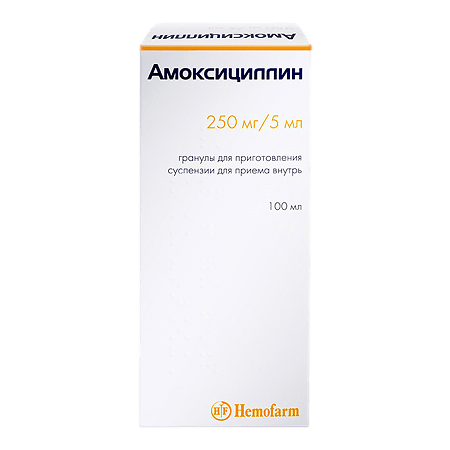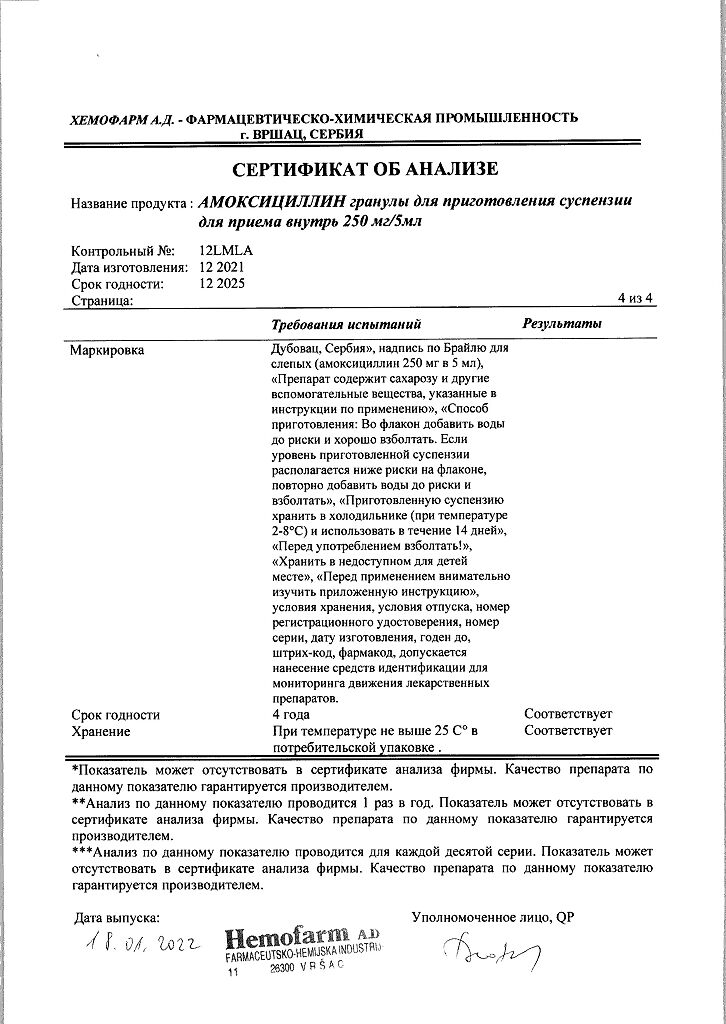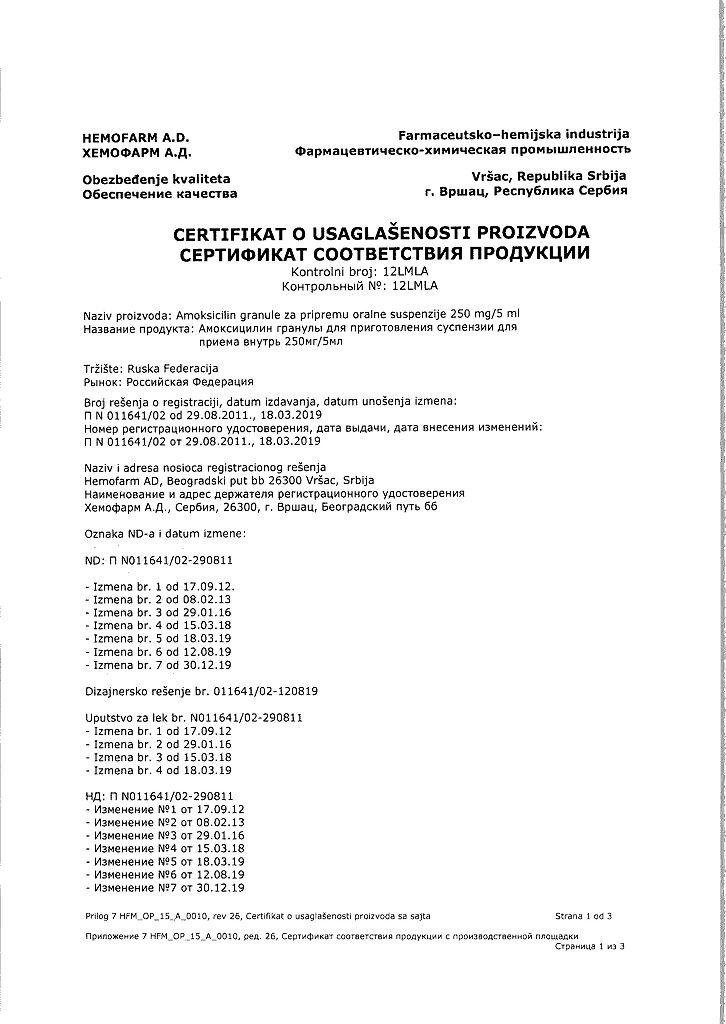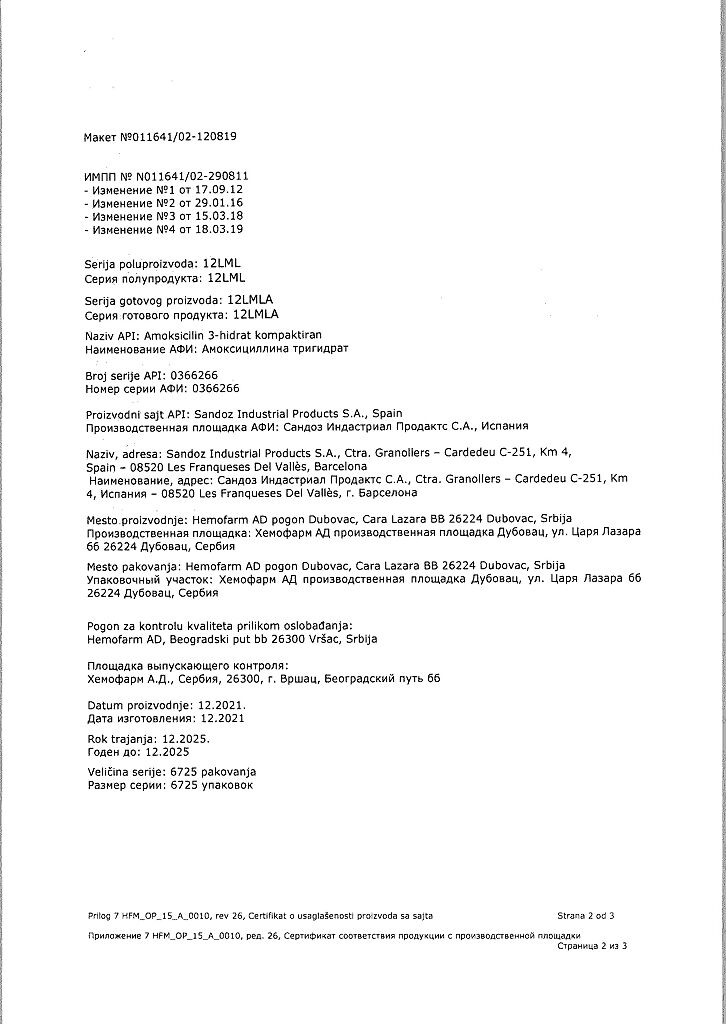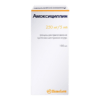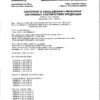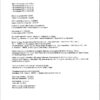No products in the cart.
Amoxicillin, 250 mg/5 ml 100 ml
€2.98 €2.48
Out of stock
(E-mail when Stock is available)
Description
Amoxicillin is an antibacterial bactericidal acid-resistant broad-spectrum agent of the group of semisynthetic penicillins.
Inhibits transpeptidase, disrupts the synthesis of peptidoglycan (a supporting protein of the cell wall) during division and growth, causes lysis of bacteria.
The drug is active against both Gram-positive and Gram-negative microorganisms due to its wide spectrum of action.
The clinically relevant gram-negative microorganisms sensitive to amoxicillin include Escherichia coli, Proteus mirabilis, Salmonella, Shigella, Campilobacter, Haemophilus influenzae, Bordetella pertussis, Leptospira, Chlamydia.
In addition, amoxicillin is active against all microorganisms sensitive to penicillin G, such as Streptococcus group A,B,C,G,H,I,M, Streptococcus pneumoniae, staphylococci and Neisseria spp, not
Penicillinase-producing, Erysipelothrix rhysiopathiae, Corynebacterium, Bacillus anthracis, Actinomycetes, Streptobacilli, Spirillium minus, Pastereulla multocida, Listeria, Spirochaeta (Leptospira, Treponema, Borrelia) and others, and <
also various anaerobic microorganisms (including peptococci, peptostreptococci, clostridia and fusobacteria).
Pharmacokinetics
Absorption is fast, high (93%), food intake has no effect on absorption, it is not destroyed in the acidic environment of the stomach.
In oral doses of 125 and 250 mg, the maximum concentration is 1.5-3 mcg/ml and 3.5-5 mcg/ml, respectively.
The action develops 15-30 min after administration and lasts 8 h. Time to reach maximum concentration after oral administration is 1-2 hours.
It has a large volume of distribution – high concentrations are found in plasma, sputum, bronchial secretion (poor distribution in purulent bronchial secretion), pleural and peritoneal fluid, urine,
content of skin blisters, lung tissue, intestinal mucosa, female reproductive organs, prostate, middle ear fluid, bone, adipose tissue, gallbladder (with normal liver function), fetal tissues.
If the dose is increased by a factor of 2, the concentration also increases by a factor of 2.
The concentration in bile exceeds the concentration in plasma by 2-4 times.
In the amniotic fluid and umbilical cord vessels, the concentration of amoxicillin is 25-30% of the level in the pregnant woman’s plasma.
Poorly penetrates the blood-brain barrier; in inflammation of the cerebral membranes (meningitis), the concentration in the cerebrospinal fluid is about 20%. Binding with plasma proteins is 17%.
Partially metabolized to form inactive metabolites. Elimination half-life is 1-1.5 hours.
It is eliminated 50-70% unchanged by kidneys through tubular (80%) and glomerular filtration (20%), liver – 10-20%.
In a small amount is excreted with breast milk. In patients with impaired renal function (creatinine clearance less than or equal to 15 ml/min) the half-life is prolonged up to 8.5 hours.
Amoxicillin is eliminated by hemodialysis.
Indications
Indications
Infectious and inflammatory diseases caused by microorganisms sensitive to amoxicillin:
Infections of the respiratory tract and ENT organs (sinusitis, pharyngitis, tonsillitis, acute otitis media; bronchitis, pneumonia), the urogenital system (pyelonephritis, pyelitis, cystitis, urethritis, gonorrhea, endometritis, cervicitis),
Infections of the skin and soft tissues (rye, impetigo, secondary infected dermatoses), leptospirosis, listeriosis, Lyme disease (borreliosis), meningitis, endocarditis (prevention), sepsis, peritonitis.
Active ingredient
Active ingredient
Composition
Composition
2 g pellets (5 ml of ready-made suspension) contain
The active ingredient – amoxicillin 250 mg (in the form of amoxicillin trihydrate);
Excipients
Sodium saccharinate dihydrate 3.250 mg
Simethicone S 184 – 7.750 mg
Simethicone S 184 – 7.750 mg/p>
Guar gum 21,000 mg
Sodium benzoate 25,000 mg
Sodium citrate dihydrate 27,000 mg
Sugarose 1642,500 mg
sugarose/p>
Strawberry edible flavoring 1,750 mg
Raspberry flavoring 5,000 mg
Strawberry flavoring 16,750 mg.
How to take, the dosage
How to take, the dosage
Overly, before or after meals.
Adults and children over 10 years of age (with body weight over 40 kg)
The standard dosage regimen is 500 mg (10 ml) 3 times a day; in severe course of infection 750 mg -1 g (15 – 20 ml) 3 times a day.
In children aged 5-10 years old 250 mg (5 ml of suspension) 3 times a day; children aged 2-5 years old – 125 mg (2.5 ml of suspension) 3 times a day; under 2 years old – 20 mg/kg of body weight a day, divided into 3 doses.
The maximum daily dose for children under 3 months of age is 30 mg/kg/day divided into 2 doses (every 12 hours).
In premature infants and neonates, the dose is reduced and/or the interval between doses is increased.
The course of treatment is 5-12 days.
Preparation of suspension: in the bottle add water to the risk and shake well. The suspension is kept in a refrigerator (at 2-8 ° C) and shall be used within 14 days.
Shake the suspension before each use. 5 ml of prepared suspension (1 scoop) contains 250 mg of amoxicillin. If there is no special recommendation, the standard dosing regimen is used. Special dosing recommendations
In acute uncomplicated gonorrhea, 3 g (60 ml) is prescribed once; when treating women, a second administration of the indicated dose is recommended.
In acute infections of the gastrointestinal tract (paratyphoid, typhoid) and biliary tract, in gynecological infections in adults 1.5-2 g (30-40 ml) 3 times a day or 1-1.5 g 4 times a day.
In case of gastric and duodenal ulcer (in combined therapy): 750 – 1000 mg 2 times a day.
In case of leptospirosis in adults: 0.5-0.75 g (10-15 ml) 4 times a day for 6-12 days. In case of salmonellosis adults – 1.5-2 g (30-40 ml) 3 times a day for 2-4 weeks.
In prophylaxis of endocarditis during minor surgical interventions in adults 3 to 4 g (60 to 70 ml) 1 hour before the procedure. If necessary a second dose is administered after 8-9 hours. In children the dose is reduced by half.
In patients with impaired renal function and creatinine clearance 15-40 ml/min, the interval between doses is increased up to 12 hours; in creatinine clearance less than 10 ml/min the dose is reduced by 15-50%; in anuria – maximum dose 2 g/day.
Interaction
Interaction
Pharmaceutically incompatible with aminoglycosides (do not mix to avoid mutual inactivation).
Antacids, glucosamine, laxatives, food, aminoglycosides – slow down and reduce absorption; ascorbic acid increases absorption.
Bactericidal antibiotics (including aminoglycosides, cephalosporins, cycloserine, vancomycin, rifampicin) – synergistic effect; bacteriostatic drugs (macrolides, chloramphenicol, lincosamides, tetracyclines, sulfonamides) antagonistic.
Increases the effectiveness of indirect anticoagulants (by suppressing intestinal microflora, reduces the synthesis of vitamin K and prothrombin index); reduces the effectiveness of estrogen-containing oral contraceptives,
drugs, in the metabolism of which para-aminobenzoic acid is formed, ethinyl estradiol – the risk of bleeding “breakthrough”.
Diuretics, allopurinol, oxyphenbutazone, phenylbutazone, nonsteroidal anti-inflammatory drugs; drugs that block tubular secretion – by reducing tubular secretion, increase the concentration.
Allopurinol increases the risk of skin rash.
Decreases clearance and increases toxicity of methotrexate.
It increases the absorption of digoxin.
Special Instructions
Special Instructions
During the course of treatment it is necessary to monitor the hematopoietic, hepatic and renal function.
The development of superinfection due to growth of microflora insensitive to it is possible, which requires appropriate changes in antibiotic therapy.
When administered to patients with bacteremia a bacteriolysis reaction (Jarisch-Herxheimer reaction) may develop.
In patients with hypersensitivity to penicillins cross-allergic reactions with other beta-lactam antibiotics are possible.
In the treatment of mild diarrhea, anti-diarrheal drugs that reduce intestinal peristalsis should be avoided; kaolin- or attapulgit-containing anti-diarrheal agents can be used.
In severe diarrhea, a physician should be consulted.
The treatment must be continued for an additional 48-72 h after clinical signs of illness have disappeared.
When estrogen-containing oral contraceptives and amoxicillin are used concomitantly, other or additional contraceptive methods should be used if possible.
Patients with diabetes mellitus should note that 5 ml of suspension (2 g pellets) contains 1.65 g of sucrose (or 0.14 bread units, CAUs), respectively, the maximum daily dose of amoxicillin contains 3.3 CAUs.
Synopsis
Synopsis
Contraindications
Contraindications
Side effects
Side effects
Allergic reactions: Urticaria, skin hyperemia, erythema, angioneurotic edema, rhinitis, conjunctivitis, fever, joint pain, eosinophilia, exfoliative dermatitis, erythema multiforme exudative,
Stevens-Johnson syndrome, acute generalized exanthematous pustulosis; serum-like reactions, allergic vasculitis, anaphylactic shock.
Digestive system disorders:
Dysbacteriosis, change in taste, vomiting, nausea, diarrhea, stomatitis, glossitis, “black hairy” tongue, discoloration of the surface layer of dental enamel, moderate increase in the activity of “liver” transaminases, hepatitis, cholestatic jaundice, pseudomembranous colitis.
Nervous system disorders:
Excitement, anxiety, insomnia, ataxia, confusion, behavioral changes, depression, peripheral neuropathy, headache, dizziness, seizure reactions.
Laboratory findings:
Leukopenia, neutropenia, thrombocytopenic purpura, anemia.
Other:
painful breathing, tachycardia, hemolytic anemia, agranulocytosis, interstitial nephritis, crystalluria, vaginal candidiasis, superinfection (especially in patients with chronic disease or reduced body resistance).
Overdose
Overdose
Symptoms: nausea, vomiting, diarrhea, water-electrolyte imbalance (as a consequence of vomiting and diarrhea).
Treatment: gastric lavage, activated charcoal, saline laxatives, drugs to maintain water-electrolyte balance; hemodialysis.
Pregnancy use
Pregnancy use
The use of amoxicillin in pregnancy is possible when the benefit to the mother exceeds the potential risk to the fetus.
Amoxicillin is excreted with breast milk in low concentrations.
If it is necessary to use the drug during lactation, discontinuation of breastfeeding should be considered.
Similarities
Similarities
Additional information
| Weight | 0.142 kg |
|---|---|
| Shelf life | 3 years. Do not use after the expiration date printed on the package. |
| Conditions of storage | At temperature up to 25 ° C in the original package, in a dry, light-protected place. Keep out of reach of children. |
| Manufacturer | Chemopharm A.D., Serbia |
| Medication form | granules for preparation of oral suspension |
| Brand | Chemopharm A.D. |
Other forms…
Related products
Buy Amoxicillin, 250 mg/5 ml 100 ml with delivery to USA, UK, Europe and over 120 other countries.

